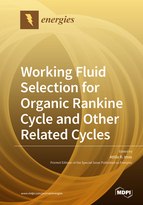Working Fluid Selection for Organic Rankine Cycle and Other Related Cycles
A special issue of Energies (ISSN 1996-1073). This special issue belongs to the section "J: Thermal Management".
Deadline for manuscript submissions: closed (28 February 2020) | Viewed by 21891
Special Issue Editor
Interests: thermodynamics; energy engineering; supercritical and metastable states; energy storage and conversion; geothermal and waste heat utilization; phase equilibria
Special Issues, Collections and Topics in MDPI journals
Special Issue Information
Dear Colleagues,
During the last few decades, power generation from low-temperature heat sources (below 300 ℃) like thermal solar, geothermal, biomass, or waste heat has become more and more significant. Since the traditional Rankine cycle using water as working fluid cannot be used with sufficient efficiency at low temperatures, the need to find novel working fluids for organic Rankine cycles or for similar, less frequently used, thermodynamic cycles (like Trilateral Flash Cycles) has become a priority.
Traditionally, the working fluid for a given ORC process is selected using a trial-and-error procedure through experience from chemically similar materials. This way, however, one might risk excluding novel, previously unused, working fluids, which could be more suitable for the given heat source than any of the traditional ones. In this Special Issue, more sophisticated methods will be presented, using optimization models, thermodynamic analyses, equation-of-state parameters, and molecular properties. The aim is to present a reliable source for researchers and innovators/developers working on ORC-related fields to help them to find the proper working fluid for any given heat source.
Prof. Attila R. Imre
Guest Editor
Manuscript Submission Information
Manuscripts should be submitted online at www.mdpi.com by registering and logging in to this website. Once you are registered, click here to go to the submission form. Manuscripts can be submitted until the deadline. All submissions that pass pre-check are peer-reviewed. Accepted papers will be published continuously in the journal (as soon as accepted) and will be listed together on the special issue website. Research articles, review articles as well as short communications are invited. For planned papers, a title and short abstract (about 100 words) can be sent to the Editorial Office for announcement on this website.
Submitted manuscripts should not have been published previously, nor be under consideration for publication elsewhere (except conference proceedings papers). All manuscripts are thoroughly refereed through a single-blind peer-review process. A guide for authors and other relevant information for submission of manuscripts is available on the Instructions for Authors page. Energies is an international peer-reviewed open access semimonthly journal published by MDPI.
Please visit the Instructions for Authors page before submitting a manuscript. The Article Processing Charge (APC) for publication in this open access journal is 2600 CHF (Swiss Francs). Submitted papers should be well formatted and use good English. Authors may use MDPI's English editing service prior to publication or during author revisions.
Keywords
- Thermodynamic cycles
- Low-temperature heat sources
- Working fluids
- Efficiency






